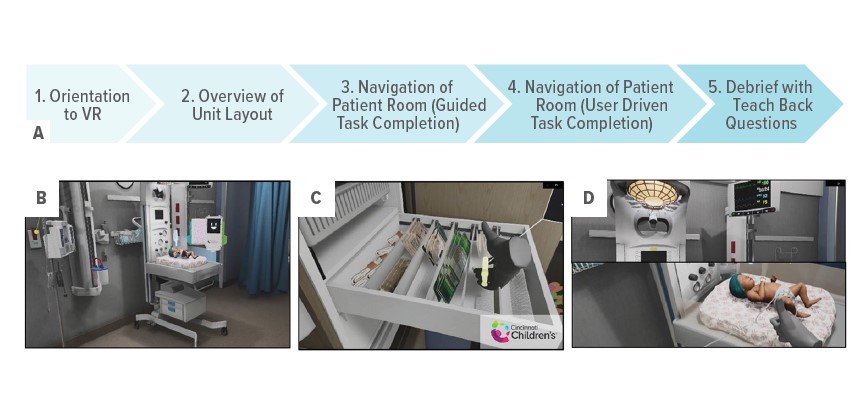Immersive Virtual Reality Onboarding a Novel Approach to Large-Scale Training
Research By: Matthew Zackoff, MD, MEd | Ryan Moore, MD, MSc
Post Date: August 13, 2022 | Publish Date: Aug. 13, 2022
Critical Care Medicine | Top Scientific Achievement


Creating a “digital twin” experience via immersive virtual reality (VR) to onboard clinical staff to a new workspace is feasible and well-received, according to the largest-scale case study ever conducted of this emerging technology.
Corresponding author Matthew Zackoff, MD, MEd, and senior author Ryan Moore, MD, MSc, led the study, which was based on the recent completion of a 632,500-square-foot critical care building that features a new emergency department and new spaces for intensive care and acute care units.
To introduce clinical staff to the space, a large team of application developers, medical animators, simulation educators, clinical experts and operational leaders collaborated to design an immersive VR onboarding experience. The team focused on building realistic, interactive and accessible replicas of three types of intensive care units plus units for Acute Care Cardiology and Bone Marrow Transplant. These units were prioritized because of their complexity and because they had the most significant changes regarding room functionality and location of resources and equipment.
The team provided clear communications and carried out a detailed timeline to train more than 2,000 frontline staff, all prior to opening the building for patient care.
“No other training modality could provide participants a comparable educational experience in the same training window, much less before the new clinical space was completed,” Zackoff says.
Since these findings were published, the research team also has published a follow-up analysis in the journal Simulation in Healthcare. The study found that across all staff demographics, rates of adverse events were low, odds of reporting immersion were high, and there was a clear preference for VR over lower-fidelity training methods.
“These combined findings demonstrate that large-scale VR onboarding is feasible, tolerable and acceptable to a diverse population of healthcare staff when using digital twin technology,” Zackoff says.

More 2023 Research Highlights
Chosen by the Division of Critical Care Medicine
Atreya MR, Cvijanovich NZ, Fitzgerald JC, et al. Detrimental effects of PCSK9 loss-of-function in the pediatric host response to sepsis are mediated through independent influence on Angiopoietin-1. Crit Care. 2023;27(1):250. Published 2023 Jun 26. doi:10.1186/s13054-023-04535-1
Gray JM, Raymond TT, Atkins DL, et al. Inappropriate Shock Delivery Is Common During Pediatric In-Hospital Cardiac Arrest. Pediatr Crit Care Med. 2023;24(8):e390-e396. doi:10.1097/PCC.0000000000003241
Bodilly L, Williamson L, Howell K, Alder MN, Kaplan JM. OBESE MICE WITH PNEUMONIA HAVE HYPERLEPTINEMIA AND INCREASED PULMONARY SIGNAL TRANSDUCER AND ACTIVATOR OF TRANSCRIPTION 3 ACTIVATION. Shock. 2023;59(3):409-416. doi:10.1097/SHK.0000000000002050
Maholtz DE, Riley CL. Screening for Social Needs in Critically Ill Patients: Addressing More Than Health Conditions. Pediatr Crit Care Med. 2022;23(11):e541-e542. doi:10.1097/PCC.0000000000003067
Stanski NL, Pode Shakked N, Zhang B, et al. Serum renin and prorenin concentrations predict severe persistent acute kidney injury and mortality in pediatric septic shock. Pediatr Nephrol. 2023;38(9):3099-3108. doi:10.1007/s00467-023-05930-0
View more discoveries from 50 research divisions and areas
Return to the 2023 Research Annual Report main features
This graphic abstract illustrates the anti-inflammatory impact of the food supplement quercetin. In mice, at four hours after inducing a hyperinflammatory state, quercetin sharply decreased blood levels of IL-1β and IL-18. In experiments using human cells, quercetin greatly reduced IL-1β secretion by monocytes following TNF-α stimulation.
| Original title: | Immersive Virtual Reality Onboarding using a Digital Twin for a New Clinical Space Expansion: A Novel Approach to Large-Scale Training for Health Care Providers |
| Published in: | The Journal of Pediatrics |
| Publish date: | Aug. 13, 2022 |
Research By









